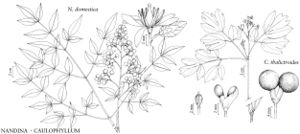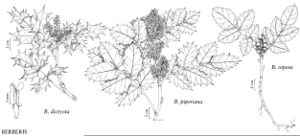Difference between revisions of "Berberidaceae"
FNA>Volume Importer |
imported>Volume Importer |
||
| (7 intermediate revisions by 2 users not shown) | |||
| Line 13: | Line 13: | ||
}}<!-- | }}<!-- | ||
| − | --><span class="statement" id="st- | + | --><span class="statement" id="st-undefined" data-properties=""><b>Herbs </b>or shrubs [trees], perennial, evergreen or deciduous, sometimes rhizomatous. <b>Stems</b> with or without spines. <b>Leaves</b> alternate, opposite, or fascicled, simple, 2-3-foliolate, or 1-3-pinnately or 2-3(-4)-ternately compound; stipules present or absent; venation pinnate or palmate. <b>Inflorescences</b> terminal or axillary, racemes, cymes, umbels (or umbel-like), spikes, or panicles, or flowers solitary or in pairs, flowers pedicellate or sessile. <b>Flowers</b> bisexual, inconspicuous or showy, radially symmetric; stipitate glands absent (except in <i>Vancouveria</i>); sepaloid bracteoles 0-9; perianth sometimes absent (<i>Achlys</i>), more frequently present, 2- or 3-merous, or sepals and petals intergrading (Nandis); sepals 6, distinct, often petaloid and colored, not spurred; petals 6-9, distinct, plane or hooded; nectary present; stamens 6; anthers dehiscing by valves or longitudinal slits; ovary superior, apparently 1-carpellate; placentation marginal or appearing basal; style present or absent, sometimes persistent in fruit as beak. <b>Fruits</b> follicles, berries, or utricles. <b>Seeds</b> 1-50, sometimes arillate; endosperm abundant; embryo large or small; mature seeds elevated on elongating stalk in <i>Caulophyllum</i>.</span><!-- |
-->{{Treatment/Body | -->{{Treatment/Body | ||
| − | |distribution=Widespread;well represented in the north temperate zone | + | |distribution=Widespread;well represented in the north temperate zone. |
|discussion=<p>Genera 15, species ca. 650 (8 genera, 33 species in the flora).</p><!-- | |discussion=<p>Genera 15, species ca. 650 (8 genera, 33 species in the flora).</p><!-- | ||
| − | --><p>Berberidaceae presents several interesting biogeographic features. Achlys is disjunct from western North America to east Asia with few morphologic differences between taxa. Diphylleia, Jeffersonia, and Podophyllum, each with a single eastern North American species, exhibit wide disjunctions to east Asia. Caulophyllum has three species, one in east Asia and two in the flora. Vancouveria is endemic to northwestern United States with nearest relations to Epimedium Linnaeus (H. Loconte and J. R. Estes 1989b; W. T. Stearn 1938), an exclusively Eastern Hemisphere genus.</p><!-- | + | --><p>Berberidaceae presents several interesting biogeographic features. <i>Achlys</i> is disjunct from western North America to east Asia with few morphologic differences between taxa. <i>Diphylleia</i>, <i>Jeffersonia</i>, and <i>Podophyllum</i>, each with a single eastern North American species, exhibit wide disjunctions to east Asia. <i>Caulophyllum</i> has three species, one in east Asia and two in the flora. <i>Vancouveria</i> is endemic to northwestern United States with nearest relations to Epimedium Linnaeus (H. Loconte and J. R. Estes 1989b; W. T. Stearn 1938), an exclusively Eastern Hemisphere genus.</p><!-- |
| − | --><p>Nandina, Berberis, Epimedium, and Podophyllum are cultivated.</p><!-- | + | --><p><i>Nandina</i>, <i>Berberis</i>, Epimedium, and <i>Podophyllum</i> are cultivated.</p><!-- |
--><p>The perianth of Berberidaceae is commonly composed of three distinct types of organs, but terminology for the organs varies from author to author. In our treatment, we refer to the small, outer parts as bracteoles (collectively forming a calyculus); the large, middle parts as sepals; and the innermost parts, which are commonly nectariferous, as petals. Some authors have referred to the bracteoles as outer sepals and to the petals as staminodes.</p> | --><p>The perianth of Berberidaceae is commonly composed of three distinct types of organs, but terminology for the organs varies from author to author. In our treatment, we refer to the small, outer parts as bracteoles (collectively forming a calyculus); the large, middle parts as sepals; and the innermost parts, which are commonly nectariferous, as petals. Some authors have referred to the bracteoles as outer sepals and to the petals as staminodes.</p> | ||
|tables= | |tables= | ||
| Line 115: | Line 115: | ||
-->{{#Taxon: | -->{{#Taxon: | ||
name=Berberidaceae | name=Berberidaceae | ||
| − | |author=R. David Whetstone T. A. Atkinson Daniel D. Spaulding | + | |author=R. David Whetstone;T. A. Atkinson;Daniel D. Spaulding |
|authority=Jussieu | |authority=Jussieu | ||
|rank=family | |rank=family | ||
| Line 123: | Line 123: | ||
|family=Berberidaceae | |family=Berberidaceae | ||
|illustrator=John Myers | |illustrator=John Myers | ||
| − | |distribution=Widespread;well represented in the north temperate zone | + | |illustration copyright=Flora of North America Association |
| + | |distribution=Widespread;well represented in the north temperate zone. | ||
|reference=ernst1964a;loconte1989b;loconte1993a;meacham1980a;nowicke1981a;ohwi1965a;terebayashi1985a;terebayashi1985b | |reference=ernst1964a;loconte1989b;loconte1993a;meacham1980a;nowicke1981a;ohwi1965a;terebayashi1985a;terebayashi1985b | ||
|publication title= | |publication title= | ||
|publication year= | |publication year= | ||
|special status= | |special status= | ||
| − | |source xml=https:// | + | |source xml=https://bitbucket.org/aafc-mbb/fna-data-curation/src/2e0870ddd59836b60bcf96646a41e87ea5a5943a/coarse_grained_fna_xml/V3/V3_839.xml |
| − | |||
| − | |||
| − | |||
| − | |||
| − | |||
| − | |||
| − | |||
| − | |||
| − | |||
| − | |||
| − | |||
| − | |||
| − | |||
| − | |||
| − | |||
| − | |||
| − | |||
| − | |||
| − | |||
| − | |||
| − | |||
| − | |||
| − | |||
| − | |||
| − | |||
| − | |||
| − | |||
| − | |||
| − | |||
| − | |||
| − | |||
| − | |||
| − | |||
| − | |||
| − | |||
| − | |||
| − | |||
| − | |||
| − | |||
| − | |||
| − | |||
| − | |||
| − | |||
}}<!-- | }}<!-- | ||
-->[[Category:Treatment]] | -->[[Category:Treatment]] | ||
Latest revision as of 22:51, 5 November 2020
Herbs or shrubs [trees], perennial, evergreen or deciduous, sometimes rhizomatous. Stems with or without spines. Leaves alternate, opposite, or fascicled, simple, 2-3-foliolate, or 1-3-pinnately or 2-3(-4)-ternately compound; stipules present or absent; venation pinnate or palmate. Inflorescences terminal or axillary, racemes, cymes, umbels (or umbel-like), spikes, or panicles, or flowers solitary or in pairs, flowers pedicellate or sessile. Flowers bisexual, inconspicuous or showy, radially symmetric; stipitate glands absent (except in Vancouveria); sepaloid bracteoles 0-9; perianth sometimes absent (Achlys), more frequently present, 2- or 3-merous, or sepals and petals intergrading (Nandis); sepals 6, distinct, often petaloid and colored, not spurred; petals 6-9, distinct, plane or hooded; nectary present; stamens 6; anthers dehiscing by valves or longitudinal slits; ovary superior, apparently 1-carpellate; placentation marginal or appearing basal; style present or absent, sometimes persistent in fruit as beak. Fruits follicles, berries, or utricles. Seeds 1-50, sometimes arillate; endosperm abundant; embryo large or small; mature seeds elevated on elongating stalk in Caulophyllum.
Distribution
Widespread, well represented in the north temperate zone.
Discussion
Genera 15, species ca. 650 (8 genera, 33 species in the flora).
Berberidaceae presents several interesting biogeographic features. Achlys is disjunct from western North America to east Asia with few morphologic differences between taxa. Diphylleia, Jeffersonia, and Podophyllum, each with a single eastern North American species, exhibit wide disjunctions to east Asia. Caulophyllum has three species, one in east Asia and two in the flora. Vancouveria is endemic to northwestern United States with nearest relations to Epimedium Linnaeus (H. Loconte and J. R. Estes 1989b; W. T. Stearn 1938), an exclusively Eastern Hemisphere genus.
Nandina, Berberis, Epimedium, and Podophyllum are cultivated.
The perianth of Berberidaceae is commonly composed of three distinct types of organs, but terminology for the organs varies from author to author. In our treatment, we refer to the small, outer parts as bracteoles (collectively forming a calyculus); the large, middle parts as sepals; and the innermost parts, which are commonly nectariferous, as petals. Some authors have referred to the bracteoles as outer sepals and to the petals as staminodes.
Selected References
Lower Taxa
Illustrations
Key
| 1 | Shrubs (aerial stems sometimes very short in Berberis repens and B. pumila). | > 2 |
| 1 | Perennial herbs. | > 3 |
| 2 | Leaves 2-3-pinnately compound; margins of leaflets entire; inflorescences panicles. | Nandina |
| 2 | Leaves simple or 1-pinnately compound; if compound, margins of leaflets toothed; inflorescences racemes or umbels, or flowers solitary. | Berberis |
| 3 | Leaves simple, 2-7(-9)-parted; usually both basal and cauline leaves present. | > 4 |
| 3 | Leaves compound; leaves all basal or (in Caulophyllum) all cauline. | > 5 |
| 4 | Flowers 2 or more in cymes or umbels; leaves 2-parted, each segment 5-9-lobed; anthers dehiscent by 2 apically hinged valves; berries dark blue. | Diphylleia |
| 4 | Flowers solitary; leaves 5-7(-9)-parted, segments lobed or not; anthers dehiscent by longitudinal slits; berries yellow, orange, red, or purplish red. | Podophyllum |
| 5 | Leaves 2-3-foliolate; flowers solitary or in dense spikes. | > 6 |
| 5 | Leaves 2-3-ternately compound; flowers in racemes, panicles, or compound cymes. | > 7 |
| 6 | Leaves 3-foliolate; perianth absent; flowers in dense spikes; British Columbia to California. | Achlys |
| 6 | Leaves 2-foliolate; perianth present; flowers solitary; e North America (w to Minnesota and Iowa). | Jeffersonia |
| 7 | Petals well developed, 4-6 mm; ovary wall persisting and enclosing seeds in fruit; leaves all basal; California to Washington. | Vancouveria |
| 7 | Petals inconspicuous, 1-3 mm; ovary wall rupturing, seeds naked at maturity; leaves cauline; e North America (w to Manitoba, Nebraska, and Arkansas). | Caulophyllum |


